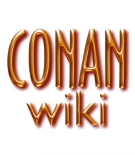Unlike the character of Howard, which is cruel, solitary and aggressive, in this live-action adaptation, Conan is a kind, sympathetic and jovial person. He is a contented member of a merry band of adventurers with a humanitarian quest. The overall theme is that Conan is a deeply honorable man – and is pushed to a comparative extreme.
The series further contrasts with the original stories in that it does not include the villain Thoth-Amon nor the evil god Set, and in that Hissah Zuhl is not based on Thoth-Amon but rather on the villain in the original The Tower of the Elephant Howard short story (the general plot basis for the first two episodes of the television series). The nature and scope of Conan's adventures are sharply limited in the television series compared to the comics and original stories (in which Conan had many occupations all over the then-known world, and many sets of clothing), as the TV Conan has a single-minded purpose (defeating Hissah Zuhl and freeing the people enslaved by him), rarely strays far from Zuhl's territory, always wears little but a loincloth, and in virtually every episode he and his band are wandering in the wilderness until either attacked by Zuhl's minions and going to a small village afterward, or going to a small village initially, only to be set upon by Zuhl's minions.
On the spiritual level, Conan's Cimmerian deity Crom in this version is not a remote, unseen god as in previous storylines, but an accessible deity who at times provides Conan direct divine assistance, and Conan is outright devout in his worship of Crom (while in previous incarnations, Conan has little faith in gods, and believes that Crom simply observes as men struggle).
Minor points of continuity between the original stories and the television series occur, especially placenames, such as Cimmeria, Conan's birthplace, and Shadizar, "the City of Wickedness" (however, most other placenames, and almost all character names, were simply invented for the TV show). The Serpent Men of Thoth-Amon in the original stories appear, but later, as minor, one-off enemies, and as servants of Hissah Zuhl, in the episode "The Taming". The quasi-Howardian Red Sonja character has a prominent but one-time role in an eponymous episode.
In appearance and style, the TV show depicts Conan like that of the films, including brown (rather than black) hair, a Germanic accent, costuming and a sword nearly identical to the filmic versions, signature sword moves from the films, jewelry in the form of an eight-spoked wheel, and other cues from the Schwarzenegger portrayal of the character, as well as an opening credits logo based on that of the films.
Another point of partial continuity with the comics is Conan's frequent spoken comment that he does not like magic; this was often expressed aloud in the comics but was usually unspoken in the Howard books.
The she-bandit character Karella is based on the "Queen of Pirates" Bêlit of the original Conan stories, and the thief Valeria of the Conan films, herself based largely on both Bêlit and the Red Sonja character of the Conan comics (yet further based on another Howard character, Red Sonya, unconnected to the original Conan stories). The show's Karella and Red Sonja characters are sufficiently different to avoid viewer confusion, as the brigand nature of Karella (inherited from the Bêlit character) is juxtaposed with the TV Sonja's duty as a holy warrior for a sect known as the Truth Keepers, and Karella is a brunette like Bêlit while Red Sonja is a redhead. Karella also appears in several of Robert Jordan's Conan Chronicles, nicknamed "The Red Hawk".
As with Subotai and The Wizard in the 1982 film, the other characters in the series are basically whole-cloth inventions for the production at hand and bear little resemblance to characters from early Conan media. Otli the dwarf in particular is entirely out-of-character for Conan as a companion (though is the provider of comic relief at the expense of other characters).
As in all previous variants of the Conan franchise, beautiful women – as strong, Amazon-like warrior women in impractically skimpy outfits, damsels in distress, or scheming femmes fatales – figure in the plot in every episode.
Points of moral and ethical message similarity between this depiction of Conan and his fictive world and the other depictions (as well as many other works of fantastical fiction and mythology in the West) include consistent themes of the value of human freedom, the importance of honor and loyalty, justice through victory, the use of (righteous, not wanton) violence as a means to justice and freedom, the value of friendship and trust, the idea that bad things come to those who dabble in evil, and the possibility of redemption for past wrongs for which reparations are made.
